World Premiere of the All-Electric Mercedes-Benz EQC
How the brand is going electric on its own terms

Today Mercedes-Benz unveiled the production version of its all-electric EQC, a midsize SUV, in an auditorium in the woods in Stockholm. Arriving at dealers in 2019, it’s the first of ten all-electric vehicles that will come to market by 2022. Dieter Zetsche, the Chairman of the Board of Management of Daimler AG and Head of Mercedes-Benz Cars made the company’s intentions very clear—they’ll be investing nearly $12 billion in bringing these cars to market and more than $1 billion in battery technology and manufacturing. Mercedes-Benz may not be first to market, but they will bring their 132 years of auto manufacturing experience to the table in a way that no other company can.
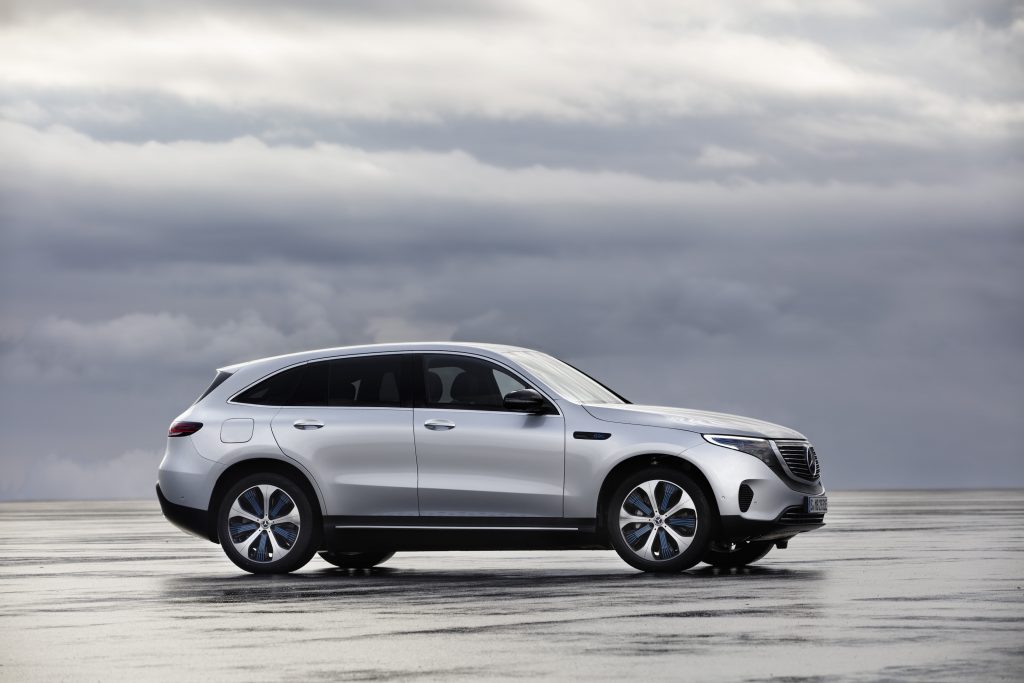
The EQC is a mid-sized SUV that Robert Lesnik, Mercedes-Benz’s Director of Exterior Design, says is “not too big, not too small. We believe this will globally be the right answer, the right product.” It will make nearly everyone who wants an easy transition into an all-electric SUV happy and it will disappoint those who were hoping that Mercedes-Benz would, in a single design, launch a vehicle unlike any production model we’ve seen. What we do know is that there are plenty of cues in the EQC’s design that hint at what we can anticipate in future EQ vehicles, and that we’re likely to see the next nine cars gradually develop a much more specific design point of view. Lesnik supports this by saying “of course we are starting to write this EQ story with certain design elements that you will see in every car in the next years.”
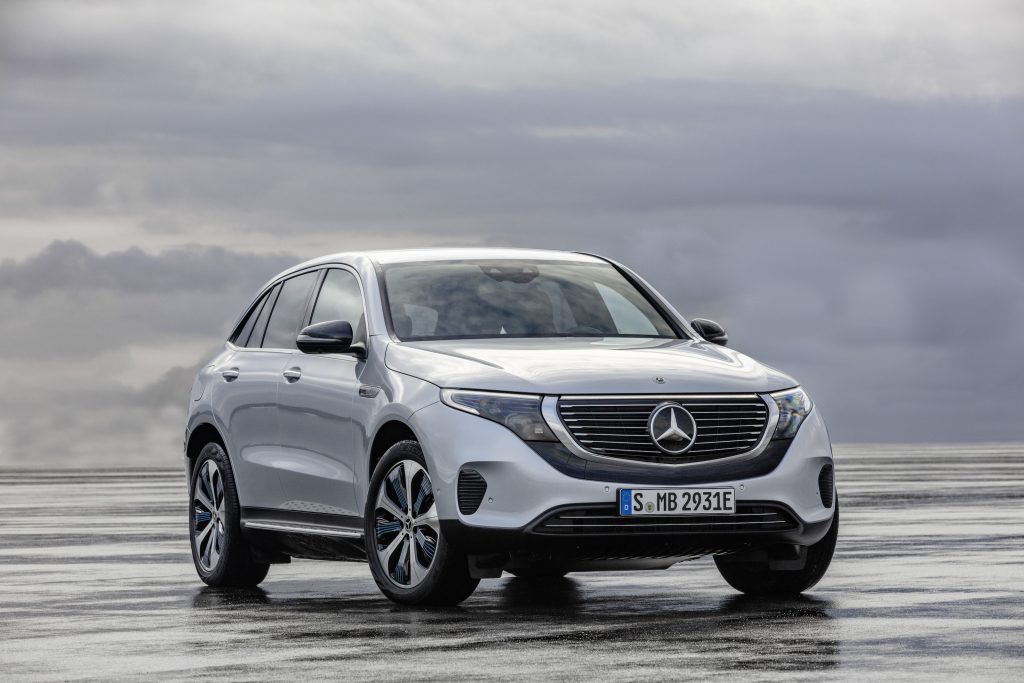
There’s a grille, despite not having an engine, a decision some may question. Large, black and balanced, topped with new signature lighting, its presence is hard to miss. When asked about it, Lesnik notes that “In this case we do have a grille, because we have air intakes,” and the taller SUV format is particularly well suited for it. He adds that when you look close up “you see from here only barely that there’s air intake. But five or ten meters away you will not see this, you’ll only see this signature Mercedes-Benz star, which is something very unique. From a hundred meters you’ll see this black panel area. The car’s lights blend together and they look like one shape. There is a face, and the car has character.”

That character seems like it’s going to be a signature of EQ, at least in many of their upcoming vehicles. He says, “What we know is you can make a provocation and take everything out and make it completely different, but that was not the goal for this car. Maybe later, maybe another car, but not with this one. So that’s one of the very important elements that you will see in similar shape on other cars to follow, and we believe it has a lot of potential.”
That may be because of what lurks behind it, and where things start to get interesting: “You have a clean, black panel surface and you can put all kinds of sensors, radars, lasers, everything behind it,” says Lesnik. Then imagine a few years from now we’ll be at level four or five autonomous driving cars and they will need many more sensors. The inspiration for this comes from the [Mercedes-Benz star insignia], which actually we have done for years. This looks like it’s 3D but it’s not; it’s not even chrome, it’s a special material. It looks like chrome but it’s not, it’s indium. Chrome has too much metal in it and it would not let our radar pass through it. We think it looks really high tech. And if we were to use that material it gives us a lot of freedom, a lot of potential to design. So a lot of the elements we need for autonomous driving we can put behind it. So while it’s an air intake in this car, it would be easy to change in others.”
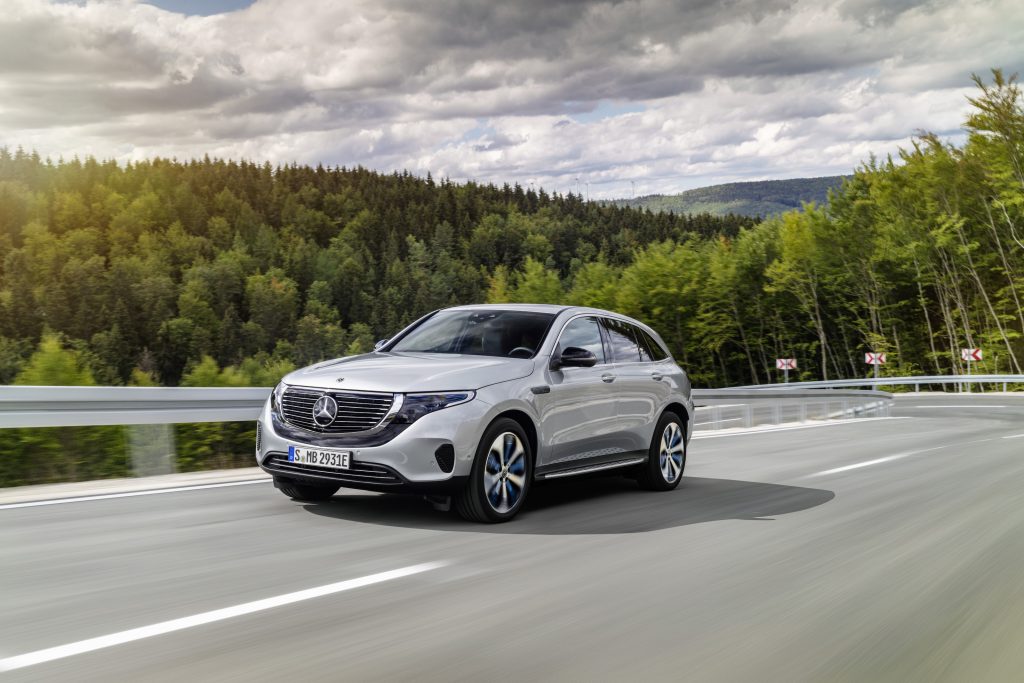
The car’s exterior design isn’t surprising, but it is cleaner, with fewer lines than existing models, something that will be part of EQ’s “premium luxury” design language. This “sensual” design is perhaps most noticeable in the car’s rear, with its graceful curves and strong light signature. Lesnik notes that most designers love to design the rear of the car, which is easier to shape and burdened by fewer regulations and sensors than the front.
There’s a lot of contrast to the lower area because of the battery pack and the large wheels. The EQC also offers a trailer hook, something “which is unusual in an electric car and our engineers are very proud of,” Lesnik shares. He also hints at another signature design element: “Normally you have a big step [on the floor of the cargo area], but it’s seamless, like one monolithic shape. This is something that you will maybe see in other classes and segments, other EQs.”
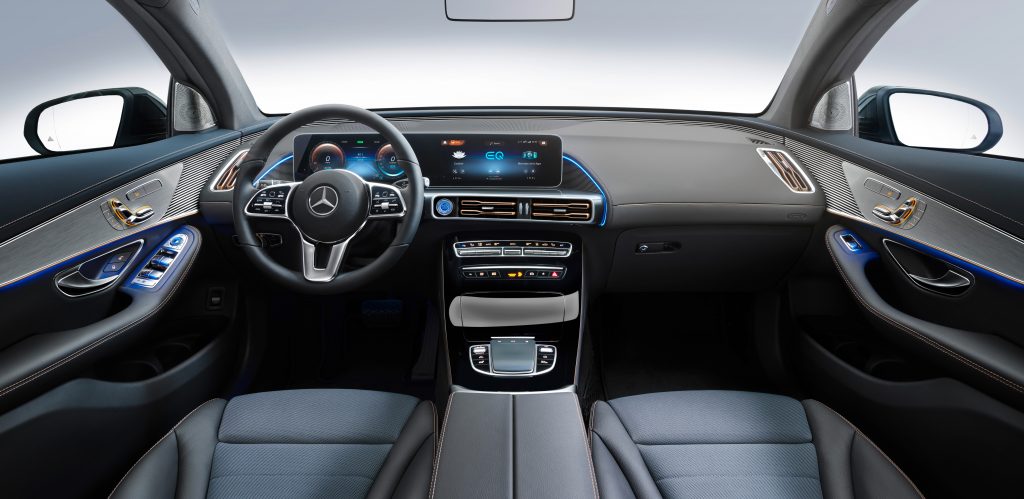
The interior of the EQC delivers several EQ design elements as well, including a new fabric made from recycled plastic bottles and a unique surface texture we haven’t seen before. “I’d love for you to feel and touch this amazing surface,” Hartmut Sinkwitz, Mercedes-Benz Director of Interior Design, says enthusiastically while we are sitting inside the SUV. “It looks like a textile, but it’s been achieved by printing. The substrate is the same material as artificial leather. It comes across as something totally new. It looks like something that someone has made with their hands. It’s tailored. It fits so well, like it’s two-dimensionally curved around [the dashboard] and together with the ultra-fine rose gold piping has a very nice effect. It will be exclusive to EQ vehicles.” Like nearly every new car we write about, the interiors, especially in the higher trim levels, get more and more refined. You’ll feel comfortable in the EQC cabin, with its clean lines and reduced clutter. It features the large display found in most models along with buttons and switches where you’d expect (and likely want) them.
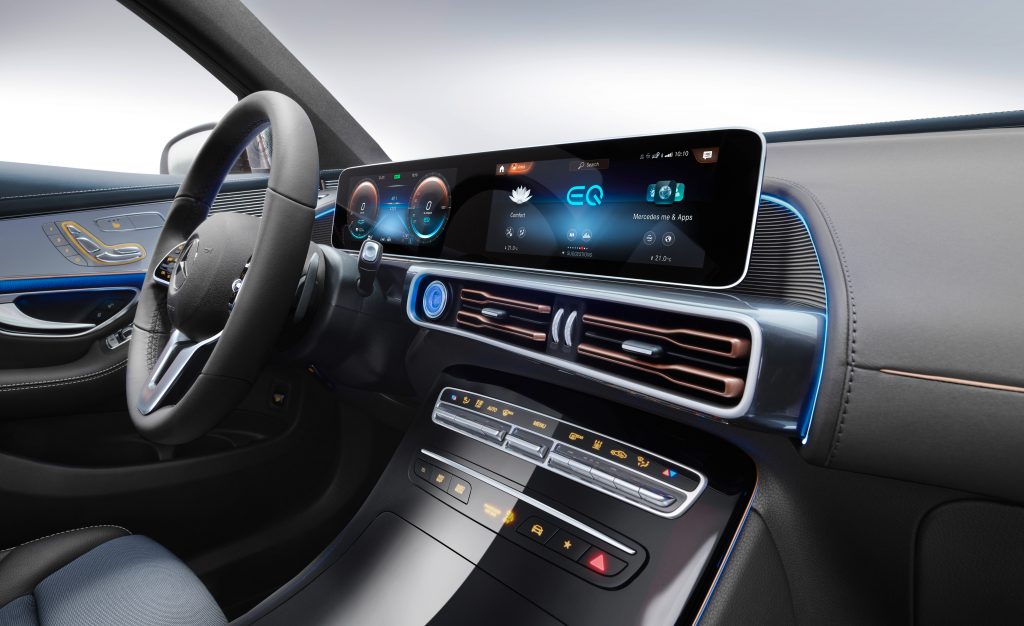
Metal gills or ribs, inspired by those on an amplifier, bring a fresh element into the cabin. Pointing to the large metal piece that wraps around the top of the dashboard, Sinkwitz says “If you imagine such a huge piece that is stable for all the hot and cold temperatures it’s really amazing that we managed to make it. These are some of the ways that we can show that we are giving this car a more electric, technical feeling through a few, nice ideas that we’ve given this interior.” Another feature is the “cassette” which holds the center stack air vents. “This very technical looking element gives you all of this depth, along with the ribs, which is a real highlight. This stages our very beautiful large screen display, but it’s very well balanced and not too dominant. The vents are very unique as well. They are powerful, and almost look they could be in a muscle car. These are great details and they will be used in several EQ cars,” he says.
There are many, many parts in the car—around 50kg worth—that are made from recycled or renewable materials, and other than the fabric most of the others you don’t see. Some exist in other models as well. “We use a lot of flax-based material in the door trims, which is lightweight and a growing, renewable resource,” Sinkwitz adds. Here too, along with the outside, the EQC shows its new design DNA on its own terms. It’s a journey EQ wants to take its customers on instead of forcing it on them. Whether this strategy will appeal to buyers will be seen.
The EQC comes with the company’s latest technology and driver assistance packages along with a few new things. An option in navigation allows you to find the most energy efficient route, for example, taking hills and other elements into consideration, and a new app sets your preferences for charging and temperature. The EQC is expected to deliver around 200 miles of range, and can charge from 10 to 80% of its battery capacity in only 40 minutes. Available in 2019 with European markets delivering first, Mercedes-Benz has finally created a viable competitor in the current electric SUV market and is showing part of its hand in the race to a very electric future, with an estimated 25% of sales by 2025. Visit Mercedes-Benz EQ to learn more.
Images courtesy of Mercedes-Benz












